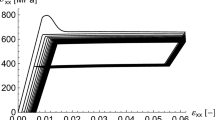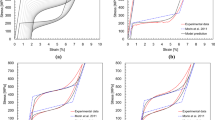Abstract
In this contribution, a modelling framework for functional fatigue in shape memory alloy wires is introduced. The approach is in particular designed to reproduce the effective response determined by experiments as published in, e.g., Eggeler et al. (Mat Sci Eng A 378:24–33, 2004). In this context, the decrease of transformation stresses, the increase of irreversible strains, and the occurrence of “characteristic points” with respect to the stress-strain relation is explicitly covered in the model formulation. The modelling approach for the phase transformations itself offers a large potential for further micromechanically well-motivated model extensions.











Similar content being viewed by others
Notes
A maximum of two simultaneously occurring discontinuities as this work proceeds.
References
Abeyaratne R, Knowles J (1990) On the driving traction acting on a surface of strain discontinuity in a continuum. J Mech Phys Sol 38:345–360
Auricchio F, Petrini L (2004) A three-dimensional model describing stress-temperature induced solid phase transformations: thermomechanical coupling and hybrid composite applications. Int J Numer Meth Engrg 61:716–737
Auricchio F, Reali A, Stefanelli U (2007) A three-dimensional model describing stress-induced solid phase transformation with permanent inelasticity. Int J Plast 23:207–226
Barrera N, Biscari P, Urbano MF (2014) Macroscopic modeling of functional fatigue in shape memory alloys. Eur J Mech A/Solids 45:101–109
Bartel T, Menzel A, Svendsen B (2011) Thermodynamic and relaxation-based modeling of the interaction between martensitic phase transformations and plasticity. J Mech Phys Sol 59:1004–1019
Bertacchini OW, Lagoudas DC, Patoor E (2009) Thermomechanical transformation fatigue of TiNiCu SMA actuators under a corrosive environment-part i: Experimental results. Int J Fatigue 31:1571–1578
Biot MA (1965) Mechanics of incremental deformations. Wiley, New York
Casati R, Passaretti F, Tuissi A (2011) Effect of electrical heating conditions on functional fatigue of thin NiTi wire for shape memory actuators. Proc Engrg 10:3423–3428
Coleman B, Noll W (1963) The thermodynamics of elastic materials with heat conduction and viscosity. Arch Rational Mech Anal 13:167–178
Demersa V, Brailovski V, Prokoshkinb SD, Inaekyana KE (2009) Thermomechanical fatigue of nanostructured Ti-Ni shape memory alloys. Mat Sci Engrg A 513–514:185–196
Edelen DGB (1973) On the existence of symmetry relations and dissipation potentials. Arch Rat Mech Anal 51:218–227
Eggeler G, Hornbogen E, Yawny A, Heckmann A, Wagner M (2004) Structural and functional fatigue of NiTi shape memory alloys. Mat Sci Eng A 378:24–33
Grossmann C, Schaefer A, Wagner MFX (2010) A finite element study on localized deformation and functional fatigue in pseudoelastic NiTi strips. Mat Sci Engrg A 527:1172–1178
Halphen B, Nguyen QS (1975) Sur les matériaux standards généralisés. J Mécanique 14:39–63
Hartl D, Lagoudas D (2007) Aerospace applications of shape memory alloys. Proc Inst Mech Eng 221:535–552
Hornbogen E (2004) Thermo-mechanical fatigue of shape memory alloys. J Mat Sci 39:385–399
Jäger P, Steinmann P, Kuhl E (2008) On local tracking algorithms for the simulation of three-dimensional discontinuities. Comput Mech 42:395–406
Jani JM, Leary M, Subic A, Gibson MA (2014) A review of shape memory alloy research, applications and opportunities. Mat Design 2014:1078–1113
Kang G, Kan Q, Yu C, Song D, Liu Y (2012) Whole-life transformation ratchetting and fatigue of super-elastic niti alloy under uniaxial stress-controlled cyclic loading. Mat Sci Engrg A 535:228–234
Lagoudas DC (2008) Shape memory alloys: modeling and engineering applications. Springer, New York
Li YF, Mi XJ, Tan J, Gao BD (2009) Thermo-mechanical cyclic transformation behavior of Ti-Ni shape memory alloy wire. Mat Sci Engrg A 509:8–13
McCormick PG, Liu Y (1994) Thermodynamic analysis of the martensitic transformation in NiTi-II. Effect of transformation cycling. Acta Metall Mater 42(7):2407–2413
Miyazaki S, Igo Y, Otsuka K (1986) Effect of thermal cycling on the transformation temperatures of Ti-Ni alloys. Acta Metal 34(10):2045–2051
Müller I, Seelecke S (2001) Thermodynamic aspects of shape memory alloys. Math Comp Modell 34:1307–1355
Nayan N, Buravalla V, Ramamurty U (2009) Effect of mechanical cycling on the stress-strain response of a martensitic Nitinol shape memory alloy. Mat Sci Engrg A 525:60–67
Olbricht J, Yawny A, Cond’o AM, Lovey FC, Eggeler G (2008) The influence of temperature on the evolution of functional properties during pseudoelastic cycling of ultra fine grained NiTi. Mat Sci Engrg A 481–482:142–145
Ostwald R, Bartel T, Menzel A (2012) Phase-transformations interacting with plasticity—a micro-sphere model applied to trip steel. Comput Mat Sci 64:12–16
Ostwald R, Bartel T, Menzel A (2015) An energy-barrier-based computational micro-sphere model for phase-transformations interacting with plasticity. Comput Methods Appl Mech Engrg 293:232–265
Petrini L, Migliavacca F (2011)Biomedical applications of shape memory alloys. J Metall. doi:10.1155/2011/501483
Robertson SW, Pelton AR, Ritchie RO (2012) Mechanical fatigue and fracture of nitinol. Int Mat Rev 57(1):1–37
Shaw JA, Kyriakides S (1998) Initiation and propagation of localized deformation in elasto-plastic strips under uniaxial tension. Int J Plast 13(10):837–871
Souza AC, Mamiya EN, Zouain N (1998) Three-dimensional model for solids undergoing stress-induced phase transformations. Eur J Mech A/Solids 17:789–806
Merzouki T, Duval TZ (2012) Finite element analysis of a shape memory alloy actuator for a micropump. Sim Mod Pract Theory 27:112–126
Wagner M (2005) Ein Beitrag zur strukturellen und funktionalen Ermüdung von Drähten und Federn aus NiTi-Formgedächtnislegierungen
Waimann J, Junker P, Hackl K (2016) A coupled dissipation functional for modeling the functional fatigue in polycrystalline shape memory alloys. Eur J Mech A 55:110–121
Weighardt SC, Maier HJ, Chumlyakov YI (2013) Dependence of functional degradation on crystallographic orientation in NiTi shape memory alloys aged under stress. J Alloys Comp 577:219–221
Wolfram S (2016) NMinimize—Wolfram language documentation. https://reference.wolfram.com/language/ref/NMinimize.html
Yawny A, Olbricht J, Sade M, Eggeler G (2008) Pseudoelastic cycling and ageing effects at ambient temperatures in nanocrystalline Ni-rich NiTi wire. Mat Sci Engrg A 481–482:86–90
Yin H, He Y, Sun Q (2014) Effect of deformation frequency on temperature and stress oscillations in cyclic phase transition of NiTi shape memory alloy. J Mech Phys Sol 67:100–128
Zaki W, Moumni Z (2007) A 3d model of the cyclic thermomechanical behavior of shape memory alloys. J Mech Phys Sol 55:2427–2454
Ziegler H (1963) Some extremum principles in irreversible thermodynamics with application to continuum mechanics. North-Holland, No. IV in Progress in Solid Mechanics
Acknowledgments
The financial support by the Mercator Research Centre Ruhr (MERCUR) through project PR-2013-0048 is gratefully acknowledged.
Author information
Authors and Affiliations
Corresponding author
Rights and permissions
About this article
Cite this article
Bartel, T., Osman, M. & Menzel, A. A phenomenological model for the simulation of functional fatigue in shape memory alloy wires. Meccanica 52, 973–988 (2017). https://doi.org/10.1007/s11012-016-0419-x
Received:
Accepted:
Published:
Issue Date:
DOI: https://doi.org/10.1007/s11012-016-0419-x




